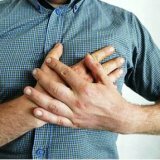Rheumatic heart disease: symptoms and treatment

Rheumatic heart disease is characterized by the involvement of all heart membranes in the inflammatory pathological process.Most painful changes begin with the muscle layer of the heart - of the myocardium, then spread to the inner shell - endocardium , with the development of inflammation in it - endocarditis, and the outer pericardium , with the appearance of pericarditis.
Rheumatic carditis is the main and specific manifestation of rheumatism( Sokolsky-Buyo disease), the main and most frequent sign of it.
We recommend reading:Earlier, especially in children, rheumatic pancarditis was common, a pathological process taking place at the same time in all the shells of the heart.At present, pancarditis is a very rare disease.The progress of medicine makes it possible to conduct modern diagnostics and active therapy, which hinders the serious development of the disease.
Note : Despite the advances in medicine, still rheumatic heart disease often results in the formation of cardiac malformations.
Table of Contents: Causes of rheumatic heart disease Classification Symptoms of clinical forms of rheumatic carditisCauses of rheumatic carditis
As already mentioned, rheumatic carditis is not an isolated disease, but an integral part of rheumatism caused by beta-hemolytic group A streptococcus.Infection is in the upper respiratory tract( tonsils).
Rheumatic carditis develops as a complication of rheumatism, which occurs in the form of allergic-inflammatory changes in the body for the presence of hemolytic streptococcus.Also, there is an opinion that the disease is caused by a response to viral and viral-streptococcal associations.A hereditary factor plays a significant role in the development of rheumatic manifestations.
The mechanism of disease development is dominated by the theory that antigens( proteins secreted by streptococcus) cause a hypersensitive reaction in the patient, accompanied by the release of specific antibodies and malfunction of immunity.These processes lead to a distortion of protective processes and the formation of autoimmune reactions that destroy the body's own connective tissue elements.In the old days they said that "rheumatism licks the joints, and gnaws at the heart."
Research on the causes of development, the mechanisms of formation of immune responses is in constant study and development.
Classification
According to A.I.Nesterov since 1973 identified three main forms of rheumatic carditis:
- weak( I degree);
- moderate( grade II);
- expressed( grade III).
The prevalence of the process was previously distinguished by diffuse and focal forms.Diffuse, thanks to modern therapy has become a rarity.The disease can occur in acute, subacute, prolonged and latent( latent) forms.
Symptoms of clinical forms of rheumatic heart disease
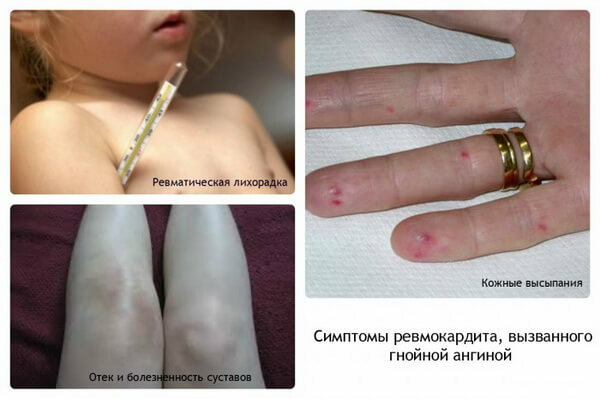
Primary rheumatic carditis( cardiac rheumatic attack) develops sharply.Weak forms are transferred almost asymptomatically and on the legs, more pronounced accompanied by painful manifestations.
Typical complaints and laboratory changes:
- abrupt temperature rise to high digits - 39-40 ° C;
- severe pain in large joints( most often in the knee);
- specific changes in the electrocardiogram;
- in blood tests - an increase in ESR, an increase in the number of leukocytes, the appearance of a C-reactive protein, a violation of the balance of proteins( dysproteinemia), an increase in the content of immunoglobulins, the detection of streptococcal antibodies.
The acute onset lasts about 1.5 - 2 months with a gradual attenuation of the manifestations, which completely disappear after 2 - 3 months.
Primary cardiac rheumatic fever occurs in three versions:
- rheumatic pericarditis;
- rheumatic myocarditis;
- rheumatic endocarditis.
Symptoms of rheumatic pericarditis
Rheumatic pericarditis can be dry and effusive( with the appearance of fluid-effusion in the cavity of the cardiac sac).The effusion usually consists of a serous fluid, sometimes with fibrinous elements.
Pain in dry form is almost absent and occurs only when complications are attached.
The appearance of effusion is accompanied by:
- by the appearance of dyspnea;
- swelling of the face, neck;
- violation of the rhythm and frequency of breathing;
- with a pronounced increase in heart rate;
- by a sudden drop in blood pressure and an increase in venous pressure;
- eructations, heartburn, discomfort in the upper abdomen( as a result of bile stasis);
- when listening and percussion( tapping) of the heart boundary increases, the pericardial friction noise is determined;
- appears a specific rheumatic nodular rash, most often in the area of the elbows, in the scalp.
Symptoms of rheumatic myocarditis
Rheumatic myocarditis develops either in a light focal form, or in a severe variant of diffuse myocarditis.
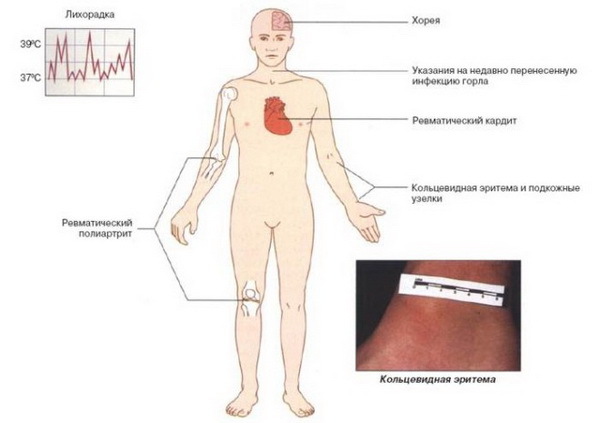
Focal myocarditis manifests itself:
- with various variants of heart rhythm disturbances;
- when listening to a phonendoscope, the doctor determines the systolic murmur, mutes 1 tone, and the accent of 2 tones on the pulmonary artery.
Symptoms of diffuse myocarditis
Diffuse myocarditis refers to severe forms of rheumatic heart disease with high mortality.
Shown:
- with restraining and pressing pains in the chest;
- with constant rapid heart rate;
- marked by shortness of breath;
- strong weakness, even to the inability to move independently;
- with periodic hemoptysis;
- with syncope;
- marked fever.
Patients are sitting in a forced position on the bed.Face of a suffering form with a pale color and a cyanotic shade.On the neck appear pulsating and swollen veins.The abdomen is enlarged( due to stagnant phenomena in the liver).
When listening, the doctor determines specific noises and changes in rhythm( canter).
Changes in blood are characterized by a pronounced increase in the content of leukocytes, a decrease in hemoglobin, a decrease in erythrocytes, increased ESR.
Characteristic signs of changes are found in ECG diagnostics( we will not describe them to the kind of complexity of perception).
Symptoms of rheumatic myocarditis
Rheumatic endocarditis manifests later symptoms of myo- and pericarditis.Complaints and symptoms of this variant are caused by a painful process in the valve apparatus of the heart.The tissue of the valves becomes inflamed, gradually replaced with coarse scar fibers, and becomes calcified.The valves stop performing their basic function, and the patient develops various heart defects, among which in the first place is mitral disease( defeat of the two-leaf valve).
In the presence of heart disease, the cells change in size, heart failure develops.When listening to heart sounds, systolic and( or) diastolic noises, combinations are clearly defined.
Symptoms and complaints characteristic of myocarditis are associated with severe heart failure.The formed heart disease leads to a worse prognosis of the disease and is difficult to treat conservatively.
Symptoms of recurrent myocarditis
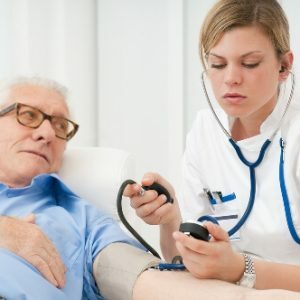 Recurrent rheumatic carditis is characterized by repeated rheumatic attacks with signs and complaints that are characteristic of lesions of the heart layers and formed defect.
Recurrent rheumatic carditis is characterized by repeated rheumatic attacks with signs and complaints that are characteristic of lesions of the heart layers and formed defect.
Reversible rheumatic heart disease can occur with a wide variety of clinical manifestations.In the first place are complaints caused by a defect( stenosis of the holes - constriction, and failure of the valves).
Return myocarditis manifests itself in two main forms:
- continuously recurrent - at which the decompensation of vices with lethal outcome is quickly formed;
- resistant with rheumosclerosis without exudative discharge .With this option, the disease slowly and steadily progresses.Gradually develops severe heart failure, cirrhosis.The outlook is unfavorable.
Diagnostics features
In the initial phases and in the absence of manifestations of endocarditis, diagnosis can be difficult due to the blurred and diverse manifestations of the disease.In practice, often there are diagnostic errors.
The physician pays special attention to:
- a long-lasting fever, continuing even after the stifling of joint complaints;
- inadequate effect of treatment only with nonspecific anti-inflammatory drugs;
- marked leukocytosis with a left shift;
- skin manifestations( nodules);
- change in heart boundaries;
- specific noise;
It is especially difficult to detect rheumatic carditis with latent current forms, which are "masked" for other diseases, or for small fever causes of an unexplained cause.In these cases, a diagnosis of "thermoneurosis" is often diagnosed.
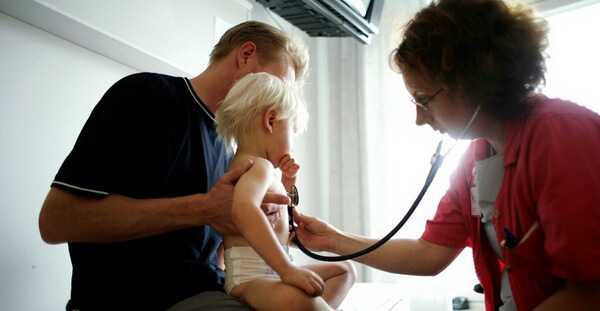
Treatment of rheumatic heart disease
Success of treatment depends on early recognition of rheumatic heart disease and prevention of heart disease.The features of treatment are determined by the form, duration and severity of the disease.Patients during an exacerbation are recommended strict bed rest.
Conservative treatment of rheumatic heart disease:
-
 antimicrobial therapy ( antibiotics of the penicillin group, sulfonamide and combination preparations).These medicines are prescribed according to certain schemes, which must be strictly observed;
antimicrobial therapy ( antibiotics of the penicillin group, sulfonamide and combination preparations).These medicines are prescribed according to certain schemes, which must be strictly observed; - anti-inflammatory therapy .In severe cases of the active phase, glucocorticosteroids( Prednisolone, Triamcinolone, Dexamethasone) are used.In lighter variants, salicylic anti-inflammatory drugs( Acetylsalicylic acid, Indomethacin, Voltaren, Ibuprofen).
- symptomatic - drugs that support the acid-base balance( Potassium Chloride, Panangin), diuretics, tranquilizers, vitamins.
After the active phase of the disease, all patients are recommended long-term spa treatment with physiotherapy - sea baths, mud.
The rehabilitation phase shows surgical treatment of rheumatic heart disease complicated by heart defects.An important role is played by therapeutic preparation of the patient for surgical treatment.
Dietary food for rheumatic carditis
Dietary food for rheumatic heart disease is intended to provide all the energy needs of the patient.The food should contain a sufficient number of animals and plant full-bodied proteins.You should limit the consumption of floury, sweet, buttery.Salt, spices, spicy dishes, coffee, strong tea should be excluded from the diet.To eat it is necessary often( 5 - 6 times a day), without overeating.
Meat and fish should be taken only in boiled form.Fresh fruit is needed to get full vitamins.You should pay attention to the need to take in sufficient quantities of products containing potassium, which is important for the normal functioning of the heart muscle.It is found in cabbage, buckwheat porridge, raisins, dried apricots, rice, dairy products, chicken eggs.
Prevention of rheumatic heart disease
Prevention of rheumatic heart disease is primarily to prevent the incidence of rheumatic fever.A healthy lifestyle, hardening, reasonable sports loads, active rest are the main measures in the prevention of any diseases and rheumatic heart disease in particular.
Special attention should be given to the treatment of acute infectious diseases caused by streptococci.
The secondary prophylaxis of patients suffering from acute phases of rheumatism is the administration of bicillin-5.
Forecast
The prognosis depends on the form of rheumatic heart disease, the date of diagnosis, treatment, the patient's mood for recovery and his behavior in the inactive phase of the disease.
Alexander Lotin, medical reviewer


